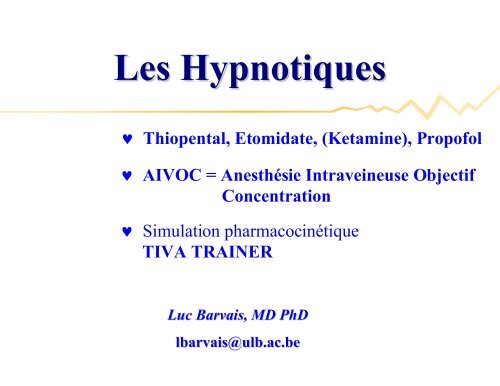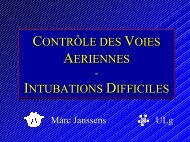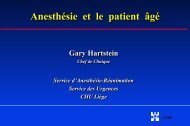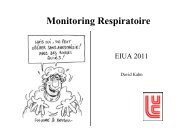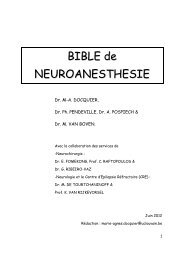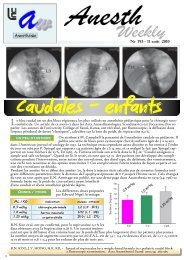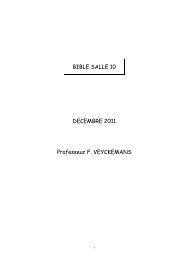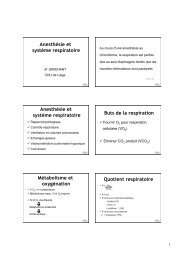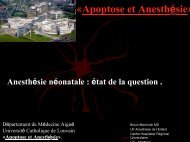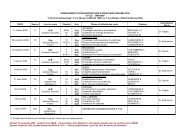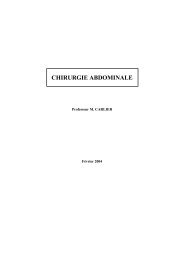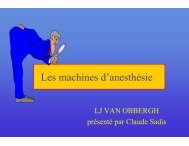Cours du Prof Barvais - virtanes
Cours du Prof Barvais - virtanes
Cours du Prof Barvais - virtanes
Create successful ePaper yourself
Turn your PDF publications into a flip-book with our unique Google optimized e-Paper software.
Les Hypnotiques<br />
Thiopental, Etomidate, (Ketamine), Propofol<br />
AIVOC = Anesthésie Intraveineuse Objectif<br />
Concentration<br />
Simulation pharmacocinétique<br />
TIVA TRAINER<br />
Luc <strong>Barvais</strong>, MD PhD<br />
lbarvais@ulb.ac.be
Thiopental<br />
‣ Barbiturique synthétisé en 1935 ; Hypnotique pur<br />
‣ Forte liposolubilité, lié albumine (85-90% et 100% à pH 7.8)<br />
‣ Métabolisation hépatique (CYT P450) avec clairance basse:<br />
2 à 4 ml/kg/min = coefficient extraction de ± 10%<br />
élimination indépendante <strong>du</strong> flux sang hépatique<br />
‣ In<strong>du</strong>ction: bolus 3 à 7 mg/kg mais ↓ doses avec l’âge.<br />
Dose à calculer en fonction poids maigre
Thiopental<br />
‣ Effet niveau SNC essentiellement sur récepteur GABA<br />
(neurotransmetteur inhibiteur).<br />
‣ ↓ consommation O2 cérébrale et ↓ débit sanguin cérébral <br />
↓volume et pression intracanienne<br />
‣ Effets hémodynamiques par effet inotrope – et ↓ précharge
Thiopental<br />
‣ Pas d’allergie<br />
‣ Pas douloureux si concentration < 2.5%<br />
‣ Contre indication = porphyrie aigue<br />
‣ Indication 2010: coma barbiturique pré ischémie cérébrale?<br />
= 10 mg/kg en 20 minutes suivi perfusion: 1 à 5 mg/kg/heure
Etomidate<br />
dérivé imidazolé éthylcarboxylé, sans structure apparentée aux<br />
autres anesthésiques<br />
Instable en solution aqueuse =solution à 2%, dans <strong>du</strong><br />
propylène glycol à 35% ou solution lipidique (Etomidate,<br />
Lipuro, B Braun)<br />
Osmolalité élevée douleurs fréquentes lors de l’injection<br />
dans des veines de petit calibre.
Etomidate<br />
T1/2 varie de 3 à 5 heures (retour lent < Vdss large)<br />
Clairance hépatique > 90% <strong>du</strong> débit sanguin hépatique<br />
0,2 à 0,3 mg.kg -1 taux plasmatiques entre 300 et 600 ng/ml<br />
assurant l’inconscience pendant 5 à 15 minutes, lorsque<br />
l’étomidate est le seul hypnotique utilisé<br />
Ampoule= 20 mg / 10 ml
Etomidate<br />
Dépression respiratoire < propofol (↓ VC + ↑ FR)<br />
In<strong>du</strong>ction peut s’accompagner hoquet et toux (20%)<br />
Myoclonies (50 à 80% si étomidate seul) = perte de<br />
l’inhibition des structures sous-corticales sur l’activité motrice<br />
extrapyramidale<br />
Inhibition enzyme 11 hydroxylase intervenant dans la<br />
synthèse <strong>du</strong> cortisol et de l’aldostérone au niveau de la<br />
corticosurrénale persistant jusque à 24h.
Etomidate<br />
Hypnosédatif intraveineux d’action rapide et brève<br />
Provoque moins de dépression cardiovasculaire et respiratoire<br />
que ses analogues<br />
Dépourvu d’effet analgésique<br />
Indiqué chez le patient atopique<br />
Diminue PIC et consommation cérébrale en oxygène<br />
Choix raisonnable pour intubation milieu extrahospitalier<br />
Inhibe la synthèse de corticoïdes et donc déconseillé en<br />
perfusion continue
KETAMINE<br />
Phencyclidine 1962<br />
Solution racémique<br />
Affinité NMDA 1 4<br />
Puissance 1 3<br />
ED 50<br />
/ LD 50<br />
1 2.5<br />
Action rapide et de courte <strong>du</strong>rée (10 à 15 min)<br />
Cytochrome P450 ; Norketamine: métabolite actif (20-30%)<br />
Altération conscience par dissociation systèmes thalamocorticales<br />
et limbiques « Catalepsie » + amnésie + analgésie<br />
Hallucinations, délire : dose-concentration dépendantes<br />
Prévention: benzodiazepines
KETAMINE: mécanismes m<br />
d’actiond<br />
Récepteurs NMDA<br />
« wind up »<br />
Stimulation polysynaptique SNC<br />
Mémorisation<br />
Récepteurs glutamate<br />
Récepteurs morphiniques (mineur)<br />
> > <br />
Voies cholinergiques et adrénergiques<br />
- Inhibition libération acétylcholine potentialisation curares<br />
- Inhibition recaptation noradrénaline, dopamine et sérotonine<br />
Récepteurs GABA (mineur)
KETAMINE : mode administration<br />
Anesthésie IV<br />
- In<strong>du</strong>ction 1-2mg.kg -1<br />
- Maintenance 10 – 90 g.kg -1 .min -1<br />
- AIVOC analgésique 0.2 – 0.5 g.ml -1 (Biais: 20%)<br />
- AIVOC hypnotique 0.6 – 1.3 g.ml -1<br />
Anesthésie IM<br />
5 -10 mg.kg -1 ; <strong>du</strong>rée ± 30-45 min ; Biodisponibilité 90%<br />
Anesthésie IR<br />
8-15 mg.kg -1 Biodisponibilité 25%
PHARMACOLOGIE KETAMINE<br />
Dépression de la fonction <strong>du</strong> myocarde<br />
S(-) > S(+)<br />
Stimulation système sympathique: adrénergique<br />
- Tachycardie<br />
- Hypertension, débit cardiaque, ou = RVP, PVC,<br />
ou= PAP et RVPulm<br />
- débit coronaire consommation O 2<br />
- Prévention avec BZD et 2-agonistes<br />
Stabilité hémodynamique en chirurgie et cathétérismes<br />
cardiaques en pédiatrie
PROPOFOL<br />
2,6-di-isopropylphénol<br />
1 ère administration chez l’homme en 1977 en BelgiquDevenu<br />
(crémophor)<br />
Peu soluble dans l’eau solvant lipidique à base de Soja<br />
Devenu agent d’in<strong>du</strong>ction de référence<br />
Agent de sédation pour endoscopie, USI, …<br />
Douleur injection!!
Propriétés s pharmacologiques <strong>du</strong><br />
propofol et concentrations<br />
Anesthésie<br />
Antiémétique<br />
Antiprurit<br />
Sédation<br />
Antiépilepsie<br />
0 0.5 1 5 10<br />
Log blood propofol concentrations (µg/ml)<br />
A. Borgeat et al. Anesthesiology 1994
Augmentation des effets <strong>du</strong> propofol<br />
chez le patient âgé<br />
Schnider et al, Anesthesiology, 1999; 90:1502-16
Comparison of the effect site keos of propofol for BIS and<br />
blood pressure in elderly and younger patients<br />
Plasma TCI : 1 to 12 µg/ml stable <strong>du</strong>ring 30 min<br />
41 patients: - Group 1: 20-39 yr<br />
- Group 2: 40-59 yr<br />
- Group 3: 60-69 yr<br />
- Group 4: 70-85 yr<br />
Kazama et al, Anesthesiology, 1999; 90: 1517-27
Comparison of the effect site keos of propofol for BIS and<br />
blood pressure in elderly and younger patients<br />
Kazama et al, Anesthesiology, 1999; 90: 1517-27
Comparison of the effect site keos of propofol for BIS and<br />
blood pressure in elderly and younger patients<br />
20-39 yr 40-59 yr 60-69 yr 70-85 yr<br />
T ½ BIS : 2.3 2.3 2.3 2.37 min<br />
T ½ SBP : 5.7 5.9 8.9 10.2 min<br />
Avec age, PAS diminue >>> mais + lentement<br />
Kazama et al, Anesthesiology, 1999; 90: 1517-27
Début<br />
action
T 1/2 k eo Propofol<br />
Cp 95 LOC = 5.4 µg/ml
Keo et T 1/2 k eo<br />
Drogue<br />
K eo<br />
minutes-1<br />
T 1/2 k eo<br />
minutes<br />
Thiopental 0.59 1.2<br />
Propofol 0.27 2.6<br />
Midazolam 0.12 5.8<br />
Alfentanil 0.53 1.7<br />
Remifentanil 0.48 1.8<br />
Fentanyl 0.12 5.8<br />
Sufentanil 0.12 5.8
Bolus et délai d<br />
Pic action des Hypnotiques<br />
thiopental
Augmentation délai d<br />
d’actiond<br />
<strong>du</strong> propofol chez le patient âgé<br />
Schnider et al, Anesthesiology, 1999; 90:1502-16
Durée<br />
action
Demi-vie<br />
élimination (h)<br />
Thiopental = 10 – 12 Fentanyl = 3.6<br />
Propofol = 1-1<br />
6 Sufentanil = 2.8<br />
Etomidate = 4 Alfentanil = 1.6<br />
Ketamine = 3 Remifent. = 0.07
V2<br />
Vc<br />
V3<br />
Cl 2<br />
Clearance<br />
Cl 3
Demi-vie Contextuelle
AIVOC ou TCI
AIVOC plasma<br />
Pharmacologie<br />
I V<br />
drogue<br />
Concentration sanguine<br />
Réponse<br />
Patient<br />
Pharmacocinétique<br />
Pharmacodynamique
Cp0<br />
C<br />
t<br />
p<br />
<br />
C<br />
0<br />
p<br />
<br />
e<br />
<br />
kel<br />
t<br />
V c<br />
Concentration<br />
Temps<br />
Clairance (ml/hr)<br />
(=Kel*Vc)
Modèle PHC à 3 exp. ou compartiments
Pharmacokinetics !!<br />
• Conc = C 1 .e -a.t + C 2 . e -b.t<br />
+ C 3 .e -p.t<br />
• k10, k12, k13, ke0, k21, k31<br />
• a1=a10+((k21*a20)+(k31*a30)+q-<br />
(e*a10))*dt; a2=a20+((k12*a10)-<br />
(k21*a20))*dt; a3=a30+((k13*a10)-<br />
(k31*a30))*dt; ct=a1/vc;
Modèle PHC à 3 compartiments<br />
2<br />
1 3
Modèle Pharmacocinétique de Marsh<br />
V 2<br />
13.8 L<br />
k 21<br />
0.055 min-1<br />
k 12<br />
0.112 min-1<br />
V 1<br />
V 3<br />
4.3L<br />
4.3L<br />
k 13<br />
0.042 min-1<br />
k 31<br />
0.0033 min-1<br />
k 10<br />
0.119 min-1<br />
238 L<br />
Marsh B et al. BJA, 1991; 67:41-48<br />
48
Prototype Diprifusor
Diprifusor (1996)
Diprifusor : Cible plasma = 3.5 µg/ml
In<strong>du</strong>ction AIVOC plasma propofol<br />
(Diprifusor)<br />
20 ans, ASA 1<br />
TCI 8 µg/ml/2min<br />
+ TCI 4 µg/ml<br />
50 ans, ASA 3<br />
TCI 4 µg/ml/2min<br />
+ TCI 2.5 µg/ml<br />
80 ans, ASA 3<br />
TCI 1 µg/ml/2min<br />
TCI 2 µg/ml/2min<br />
TCI 3 µg/ml/2min<br />
+ TCI 2 µg/ml
Maintenance AIVOC Propofol PLASMA<br />
ropofol µg/ml<br />
4<br />
2<br />
Anxiété<br />
BZD<br />
Intubation<br />
Intubation<br />
Relaxation musculaire<br />
Incision Incision<br />
Propofol<br />
Chirurgie<br />
Réveil<br />
S<br />
t<br />
i<br />
m<br />
u<br />
l<br />
a<br />
t<br />
i<br />
o<br />
n
TCI compared with manually controlled infusion<br />
of propofol : a multicentre study<br />
• Bénéfices <strong>du</strong> Diprifusor =<br />
‣ facile à utiliser avec training minimal<br />
‣ nombre interventions anesthésiste<br />
siste<br />
‣ incidence des mouvements<br />
‣ rapidité <strong>du</strong> réveilr<br />
‣ …<br />
Servin F et al. Anaesthesia 1998; 53: 82-86<br />
86
Predictive accuracy of propofol in a<strong>du</strong>lt<br />
patients using three different PHK sets<br />
Propofol (µg/ml)(<br />
6<br />
5<br />
4<br />
3<br />
2<br />
1<br />
*<br />
*<br />
*<br />
* *<br />
*<br />
*<br />
*<br />
*<br />
* *<br />
Time<br />
*<br />
*<br />
*<br />
* *<br />
* *<br />
10<br />
**<br />
25<br />
50<br />
100<br />
Bias = - 7 %<br />
MDAPE = + 18 %<br />
Wobble = + 10 %<br />
Coetzee JF et al. Anesthesiology, 1995; 82:1328-45
Positive Bias of the DIPRIFUSOR<br />
Patients âgés<br />
Swinhoe CF et al. BJA 1995; suppl 1: A276<br />
Patients subissant chirurgie cardiaque<br />
<strong>Barvais</strong> L et al. J. of CTV Anesthesia, 1996; 10:877-883<br />
*<br />
*<br />
* **<br />
* **<br />
10<br />
25<br />
50<br />
100<br />
%<br />
Bas débit cardiaque, hypothermie, …
Bias and inaccuracy of PHK sets<br />
for opioid drugs<br />
MDPE MDAPE Author<br />
Propofol - 7 % 18.2 % Marsh<br />
Sufentanil - 10 % 20.7 % Gepts<br />
Fentanyl - 4 % 21 % Mac Clain<br />
Alfentanil + 1 % 17 % Scott<br />
Remifentanil + 1 % 19 % Minto
Hysteresis : Temps pic effet<br />
1.6 mg/kg propofol in 25 Time to Peak<br />
Munoz et al, , Anesthesiology, 2004, , December, 101:1269<br />
:1269-74
Site d’action d<br />
des agents hypnotiques<br />
plasma<br />
concentration<br />
Keo<br />
Pharmacocinétique<br />
(AIVOC site effet)<br />
Pharmacodynamique<br />
(EEG, AEP, BP, HR)
Modèle PHC à 4 compartiments<br />
Keo<br />
2<br />
1 3
Modèle PHC à 4 compartiments<br />
Effect compartment<br />
Keo<br />
ffect-site compartment concentration (Ce) being not measurable, the assumption sumption i<br />
ade that the drug concentration in the effect site compartment is equivalent to the<br />
lasma concentration, which would pro<strong>du</strong>ce the same clinical effect at steady state.
EUROANAESTHESIA 2003<br />
TCAnaesthesia system = Primea (Fresenius CE)
Pompe perfusion site effet
AIVOC Propofol site effet<br />
Propofol µg/ml<br />
9<br />
8<br />
7<br />
6<br />
5<br />
4<br />
3<br />
2<br />
1<br />
0<br />
2.8<br />
Blood conc.<br />
Effect conc.<br />
Rate(ml/hr)<br />
-1 1 3 5 7 9 11 13 15<br />
1400<br />
1200<br />
1000<br />
800<br />
600<br />
400<br />
200<br />
0<br />
Rate ml/hr
AIVOC Propofol site effet<br />
9<br />
1400<br />
Propofol µg/ml<br />
8<br />
7<br />
6<br />
5<br />
4<br />
3<br />
2<br />
1<br />
Blood conc.<br />
Effect conc.<br />
Rate(ml/hr)<br />
1200<br />
1000<br />
800<br />
600<br />
400<br />
200<br />
Rate ml/hr<br />
0<br />
0<br />
0 5 10 15 20 25 30 35 40
In<strong>du</strong>ction propofol site effet<br />
20 ans, ASA 1<br />
+ AIVOC 4 µg/ml<br />
50 ans, ASA 3<br />
+ AIVOC 2.5 µg/ml<br />
80 ans, ASA 3<br />
AIVOC 1 µg/ml/2min<br />
AIVOC 2 µg/ml/2min
One-way valve + re<strong>du</strong>ced dead space
Valve uni-directionnelle
Case report: déconnection d<br />
voie IV!
Case report: fuite Propofol!
30 cm ligne perfusion<br />
=<br />
1.5 ml espace mort
Empty bottle<br />
Propofol (µg/ml)<br />
6<br />
5<br />
4<br />
3<br />
2<br />
1<br />
0<br />
0 20 40 60 80 100 120<br />
Time (min)<br />
'real' concentration<br />
Target
Variabilité PHC/PHD<br />
Réponse<br />
PHC variabilité<br />
Dose<br />
PHC variabilité
Quel sensor pour monitorer l’hypnose? l<br />
Components of BIS<br />
Bispectral Index Scale<br />
100<br />
80<br />
60<br />
40<br />
20<br />
SyncFastSlow<br />
BetaRatio<br />
QUAZI<br />
SR<br />
BIS<br />
0<br />
0 1 2 3 4 5 6 7<br />
Target propofol concentration (µg/ml)
BIS to prevent awareness <strong>du</strong>ring anaesthesia:<br />
the B-Aware B<br />
randomised controlled trial<br />
‣ Question : BIS Guided anaesthesia re<strong>du</strong>ces the<br />
incidence of awareness <strong>du</strong>ring surgery in a<strong>du</strong>lts ?<br />
‣ Prospective, randomised, double-blind, blind, multicentre<br />
trial in high risk a<strong>du</strong>lt patients under relaxant GA<br />
‣Caesarean Section<br />
‣EF < 30%, CI < 2.1 L/min/m², , pulm. HT<br />
‣OFF-pump, Aortic Stenosis<br />
Myles et al, Lancet 2004; 48(1): 20-26<br />
26
BIS to prevent awareness <strong>du</strong>ring anaesthesia: the B-B<br />
Aware randomised controlled trial<br />
‣ 1225 Groupe BIS 1238 Routine Groupe sans BIS<br />
<br />
<br />
Episodes de conscience<br />
2 p=0.022 11<br />
‣ Anesthésie sie guidée e par EEG ré<strong>du</strong>it r<br />
le risque de 82%<br />
Myles et al, Lancet 2004; 48(1): 20-26<br />
26
AIVOC propofol et monitorage EEG<br />
ASA<br />
≥ 3<br />
3 ème<br />
age (> 65-70 ans)<br />
Anesthésie<br />
sie ≥ 3h<br />
Débit cardiaque < 3L/min<br />
BMI > 30
BIS and Entropy indices at propofol-in<strong>du</strong>ced loss<br />
of consciousness in young and elderly patients<br />
Lysakowski and al. BJA 2009; 103: 387-93
Contrôle AIVOC propofol boucle fermée<br />
<strong>Barvais</strong> Luc, Hôpital Erasme,<br />
lbarvais@ulb.ac.be
BIS and Entropy indices at propofol-in<strong>du</strong>ced loss<br />
of consciousness in young and elderly patients<br />
n a<strong>du</strong>lts undergoing propofol in<strong>du</strong>ction, BIS and Entropy<br />
t loss of consciousness are significantly affected by age<br />
Lysakowski and al. BJA 2009; 103: 387-93
AVANTAGES AIVOC<br />
• AIVOC = prédiction concentrations site action /<br />
Halogénés = monitoring concentration expiratoire<br />
• Aussi simple à utiliser qu’un vaporisateur<br />
• Titration indépendante hypnotiques et analgésiques
AVANTAGES TIVA<br />
‣ Contrôle sédation avant in<strong>du</strong>ction<br />
‣ Moins de pollution Qop et environnement<br />
‣ Pas hépatite<br />
‣ Beaucoup moins de nausées vomissements<br />
‣ Accès airway non lié administration anesthésie<br />
‣ Continuité sédation postopératoire<br />
‣ Réflexe vasoconstriction hypoxique maintenue<br />
‣ Sécurité >> risque hyperthermie maligne
Addition Synergie<br />
D<br />
r<br />
o<br />
g<br />
u<br />
e<br />
B<br />
1 + 1 = 2 : Propofol - Etomidate<br />
1 + 1 = 3 : Propofol – Opioid<br />
1 + 1 = 3.5 : BZD – Opioid<br />
1 + 1 + 1 = 5 : BZD – Pro – Opioid<br />
D r o g u e A<br />
Vuyk et al : Anesthesiology, December1997<br />
+ Bouillon et al. and Kern et al : Anesthesiology, June 2004
Interaction of Propofol and Sevoflurane on<br />
Loss of Consciousness and Movement to Skin<br />
Incision <strong>du</strong>ring General Anesthesia<br />
‣ 36 patients ; Dixon up-down method ; LOC<br />
1 + 1 = 2<br />
Propofol + SEVO<br />
Harris R et al Anesthesiology 2006; 104: 1170-5
Chirurgie gynécologique<br />
70<br />
60<br />
50<br />
40<br />
30<br />
20<br />
10<br />
0<br />
Sevo<br />
64%<br />
Prop<br />
5%<br />
PONV<br />
Sevo<br />
Prop<br />
36%<br />
0%<br />
Antiemetic<br />
Nelskylä K, Korrtila K, Yli-Hankala A. British Journal of Anaesthesia 1999: 83; 576-9
PONV
AIVOC = Anesthésie sie Intraveineuse<br />
Objectif Concentration
Merci
Differences between PHK models<br />
Propofol Schnider<br />
T1/2 k eo = 1.8 min<br />
V1 := 4.27 .<br />
V2 := 18.9 + (-0.391*(age-53)) .<br />
V3 := 238.0 .<br />
Cl1 := 1.89+((weight-77)*0.0456)+<br />
((lbm-59)*(-0.0681))+((height-177)*0.0264) .<br />
Cl2 := 1.29 + (-0.024*(age-53)).<br />
Cl3 := 0.836 .<br />
Propofol Marsh<br />
T1/2 k eo = 2.6 min<br />
Schnider et al, Anesthesiology, 1999; 90:1502-16
Propofol/remifentanil TCAnaesthesia<br />
ropofol Remifentanil<br />
g/ml ng/ml<br />
4 4<br />
2 2<br />
Anxiety<br />
Intubation<br />
Remifentanil<br />
Incision<br />
Propofol<br />
Surgery<br />
S<br />
t<br />
i<br />
m<br />
u<br />
l<br />
a<br />
t<br />
i<br />
o<br />
n<br />
BZD<br />
Muscle relaxation<br />
Awakening
Bispectral Index<br />
100<br />
70<br />
60<br />
40<br />
FULLY AWAKE<br />
Sedation<br />
LIGHT SEDATION<br />
Risk of explicit or implicit mem<br />
MODERATE SEDATION<br />
Loss of consciousness<br />
DEEP HYPNOTIC LEVEL<br />
0<br />
ELECTRIC SILENCE
BIS or Entropy?<br />
Author Journal Yr Anesth. Technique Results<br />
Vakkuri Acta Scand 2004 Propofol or thiopental<br />
Bolus<br />
Vanluchene Anesthesiology 2004 Propofol 50 mg/min<br />
BSR>80;MAP SE<br />
SE, BIS: information≡<br />
allow ≠ Anesthesia φ<br />
Prediction LVC and<br />
LOC: SE > BIS<br />
≠ > 20 units observed<br />
between SE and BIS<br />
Less Interference with<br />
SE than using BIS
≠ between BIS and Entropy
Duration<br />
of action
T 1/2 contextuelle<br />
T1/2 vie (min)<br />
300<br />
250<br />
200<br />
150<br />
100<br />
50<br />
alfentanil<br />
fentanyl<br />
Sufentanil<br />
propofol<br />
0<br />
0 0,5 1 2 3 4 5 6 7 8 9<br />
Durée e de perfusion (heures)<br />
Hughes et al, Anesthesiology 1992 ; 76: 334-341<br />
341
Bolus ou perfusion courte <strong>du</strong>rée<br />
C2<br />
C1<br />
C3
Bolus ou arrêt perfusion courte <strong>du</strong>rée<br />
C2<br />
C1<br />
C3
Bolus ou arrêt perfusion courte <strong>du</strong>rée<br />
C2<br />
C1<br />
C3
Bolus ou arrêt perfusion courte <strong>du</strong>rée<br />
C2<br />
C1<br />
C3
Alfentanil perfusé pendant 10 min<br />
ng/ml<br />
200<br />
150<br />
100<br />
50<br />
0<br />
10 30 50 70 90 110<br />
minutes après s l’arrêt l<br />
de la perfusion
Perfusion longue <strong>du</strong>rée<br />
C2<br />
C2<br />
C1<br />
C3
Arrêt après s perfusion longue <strong>du</strong>rée<br />
C2<br />
C2<br />
C1<br />
C3
Arrêt après s perfusion longue <strong>du</strong>rée<br />
C2<br />
C1<br />
C3
Arrêt après s perfusion longue <strong>du</strong>rée<br />
C2<br />
C2<br />
C1<br />
C3
Arrêt après s perfusion longue <strong>du</strong>rée<br />
C2<br />
C1<br />
C3
Arrêt après s perfusion longue <strong>du</strong>rée<br />
C2<br />
C1<br />
C3
Arrêt après s perfusion longue <strong>du</strong>rée<br />
C2<br />
C1<br />
C3
Alfentanil perfusé pendant 100 min<br />
g/ml<br />
200<br />
150<br />
100<br />
50<br />
0<br />
100 150 200 250 300 350<br />
minutes après s l’arrêt l<br />
de la perfusion
Alfentanil perfusé pendant 100 min<br />
ng/ml<br />
200<br />
150<br />
100<br />
50<br />
0<br />
100 150 200 250 300 350<br />
minutes après s l’arrêt l<br />
de la perfusion
Alfentanil perfusé pendant 10 et 100 min<br />
ng/ml<br />
200<br />
150<br />
100<br />
50<br />
0<br />
100 150 200 250 300 350<br />
minutes après s l’arrêt l<br />
de la perfusion
Alfentanil perfusé pendant 10 et 100 min<br />
ng/ml<br />
200<br />
150<br />
100<br />
50<br />
0<br />
100 150 200 250 300 350<br />
Minutes après s l’arrêt l<br />
de la perfusion
Perfusion longue <strong>du</strong>rée, clairance élevée<br />
C2<br />
C2<br />
C1<br />
C3
Arrêt perfusion longue <strong>du</strong>rée, clairance élevée<br />
C2<br />
C2<br />
C1<br />
C3
Arrêt perfusion longue <strong>du</strong>rée, clairance élevée<br />
C2<br />
C2<br />
C1<br />
C3
Arrêt perfusion longue <strong>du</strong>rée, clairance élevée<br />
C2<br />
C1<br />
C3
Arrêt perfusion longue <strong>du</strong>rée, clairance élevée<br />
C2<br />
C1<br />
C3
Arrêt perfusion longue <strong>du</strong>rée, clairance élevée<br />
C2<br />
C1<br />
C3
Arrêt perfusion longue <strong>du</strong>rée, clairance élevée<br />
C2<br />
C1<br />
C3
Arrêt perfusion longue <strong>du</strong>rée, clairance élevée<br />
C2<br />
C1<br />
C3
Arrêt perfusion longue <strong>du</strong>rée, clairance élevée<br />
C2<br />
C1<br />
C3
Remifentanil perfusé pendant 100 min<br />
ng/ml<br />
10<br />
5<br />
0<br />
100 105 110 115 120<br />
minutes après s l’arrêt l<br />
de la perfusion
Remifentanil perfusé pendant 100 min<br />
ng/ml<br />
10<br />
5<br />
0<br />
100 105 110 115 120<br />
minutes après s l’arrêt l<br />
de la perfusion
Alfentanil / Remifentanil<br />
ng/ml<br />
200<br />
ng/ml<br />
10<br />
150<br />
100<br />
5<br />
50<br />
0<br />
0<br />
100 150 200 250 300 350<br />
minutes après s l’arrêt l<br />
de la perfusion
Targeting effect compartment or central<br />
compartment concentration of propofol :<br />
What predicts loss of consciousness ?<br />
Wakeling et al, Anesthesiology, 1999; 90: 92-7


